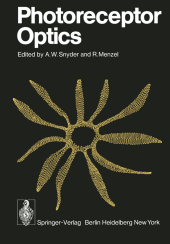 Neuerscheinungen 2012Stand: 2020-01-07 |
Schnellsuche
ISBN/Stichwort/Autor
|
Herderstraße 10
10625 Berlin
Tel.: 030 315 714 16
Fax 030 315 714 14
info@buchspektrum.de |

R. Menzel, A. W. Snyder
(Beteiligte)
Photoreceptor Optics
Herausgegeben von Snyder, A.W.; Menzel, R.
Softcover reprint of the original 1st ed. 1975. 2012. x, 526 S. X, 523 pp. 259 figs. 244 mm
Verlag/Jahr: SPRINGER, BERLIN 2012
ISBN: 3-642-80936-7 (3642809367)
Neue ISBN: 978-3-642-80936-1 (9783642809361)
Preis und Lieferzeit: Bitte klicken
The above consideration indicates that at present many of the experi mental facts on PS in animals can be quantitatively explained within the limits of the "universal" photoreceptor membrane concept. Of course, existence of preferential orientation of the absorbing dipoles in the tubuli of the rhabdomeres can not be totally rejected. We hope that the concept of the "universal" photoreceptor membrane may serve as the useful instrument when dealing with newly discovered properties of visual cells so that true mechanisms of electrical and optical coupling will be searched for instead of assumptions being made on additional properties of the photoreceptor membrane in every new animal under study. 5. Absorption Spectrum of the Universal Photoreceptor Membrane and Spectral Sensitivity of the Photoreceptor 5. 1 Preliminary Notes It seems nearly self-evident that the absorption spectrum of the pho toreceptor membrane coincides exactly with that of the visual pigment it contains. Hence, the membrane must exhibit three bands of absorp tion - the principal band with its peak within the limits of visible spectrum (or a-peak); the secondary band between 340 and 380 nm (S peak); and the third, protein band, in the ultraviolet (UV) at 280 nm (COLLINS et al. , 1952). The main peak of absorption is located within the range 433-575 nm for retinol-based pigments and between 438 and 620 nm for 3-dehydroretinol-based pigments, the position of Amax de pending on many ecological factors.
to Photoreceptor Optics - An Overview.- Section A. Photoreceptor Waveguide Optics.- A.1 Vertebrate Rod Receptors Are Directionally Sensitive.- A.2 Photoreceptor Optics - Theoretical Principles.- A.3 Waveguide Mode Effects, Birefringence and Dichroism in Fly Photoreceptors.- A.4 Physiological Optics of the Fused Rhabdom.- A.5 Sampling of the Visual Environment by the Compound Eye of the Fly: Fundamentals and Applications.- A.6 Optical Qualities of the Fly Eye - An Approach from the Side of Geometrical, Physical and Waveguide Optics.- A.7 Theory of the Stiles-Crawford Effect of the Second Kind.- A.8 Angular Sensitivity of Lens-Photoreceptor Systems.- A.9 Optical Interaction between Retinal Receptors.- A.10 The Function of the Nonguided Light in Some Explanations of the Stiles-Crawford Effects.- A.11 Light Absorption in an Idealised Photoreceptor on the Basis of Waveguide Theory.- Section B. Membrane and Dichroism.- B.1 Birefringence, Dichroism and Rod Outer Segment Structure.- B.2 The Role of the Photoreceptor Membrane in Photoreceptor Optics.- B.3 Membranes, Dichroism and Receptor Sensitivity.- Section C. Photopigment, Membrane and Dichroism.- C.1 Photoregeneration and the Adaptation Process in Insect Photoreceptors.- C.2 Dark Regeneration of Invertebrate Visual Pigments.- C.3 Photokinetics and Dichroism of Visual Pigments in the Photoreceptors of Eledone (Ozoena) moschata.- C.4 The Photochemical Equilibrium in Rhabdomeres of Eledone and Its Effect on Dichroic Absorption.- Section D. Polarisation Sensitivity and Dichroism.- D.1 The Optics of Polarization Sensitivity.- D.2 Polarisation Sensitivity in Insect Eyes with Fused Rhabdoms.- D.3 Polarisation Sensitivity of Twisted Fused Rhabdoms.- D.4 The Polarization Sensitivity - Dichroic Absorption Paradox in Arthropod Photoreceptors.- D.5 Electron Microscopic Investigations on the Structure of the Photoreceptor Cells in the Compound Eye of Ascalaphus macaronius. (Insecta: Neuroptera). (Preliminary Note).- Section E. Photomechanical Responses of Photoreceptors.- E.1 Mechanisms of Photomechanical Movement.- E.2 Properties and Functions of Screening Pigments in Insect Eyes.- Section F. Electrophysiology of Photoreceptors.- F.1 Arthropod Receptor Optics.- F.2 Receptor Function in the Apposition Eye. An Electrophvsiological Approach.- F.3 Membrane Structure and Transduction Mechanism of Visual Receptors.


